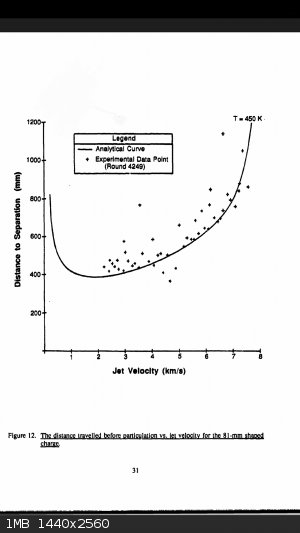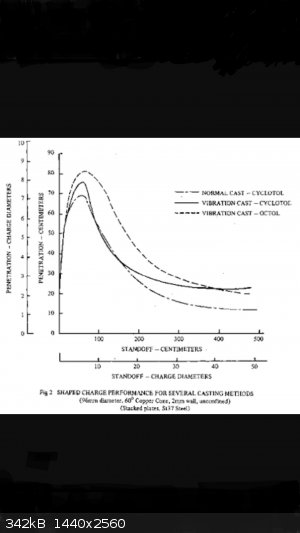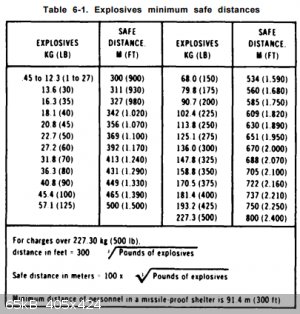Practicaler
Harmless

Posts: 42
Registered: 24-3-2012
Member Is Offline
Mood: Exploding
|
|
shaped charges safety and effective range of jet formed!!
Hey everyone !!
Recently i am working with shaped charges !! Mostly the conical one!! Well there are certain things i m really concerned about !!
Dimensions of my shaped charge i usually work with -total length of the cylindrical portion in my shaped charge is generally from 12cm to 15 cm
.inner diameter 6 cm . Thickness 2 mm. The cone i use us made up of copper that perfectly invertedly fits inside the cylindrical portion with height
of 4 cm.
Generally i pack it with PETN or ETN+NG even some times pure cyclonite.
Till now the shaped sharges i have always used in abandoned fields where no one even lives upto 30 km in all directions and all the shaped charges
always face downward !! Conical portion facing the earth .
Now my real concern is that -
As we know jet formed of copper moves with extreme velocity that is few km/sec.
Now the point arises suppose ur charge is facing towards any direction let it be east. Now what canbe the effective range of copper jet when u
detonate !! Can this jet reaches few km within a few sec and can be lethal for some person who is having a relax time fee km away ??? .
|
|
|
PHILOU Zrealone
International Hazard
    
Posts: 2893
Registered: 20-5-2002
Location: Brussel
Member Is Offline
Mood: Bis-diazo-dinitro-hydroquinonic
|
|
The speed of the projectile will be reduced by the air friction down to a constant speed within less than a km range.
Only high speed spinning projectiles (onto their axis) can drill air at very high speed without loosing too much speed (see sniper canon and bullets).
More than probably the explosive formed projectile will collapse and fragment during travel.
Yes metallic projectiles or fragments even if not at initial speed may transperce, hit and hurt or kill...just like when shooting and random people
far away is hit by a lost bullet.
PH Z (PHILOU Zrealone)
"Physic is all what never works; Chemistry is all what stinks and explodes!"-"Life that deadly disease, sexually transmitted."(W.Allen)
|
|
|
MineMan
National Hazard
   
Posts: 998
Registered: 29-3-2015
Member Is Offline
Mood: No Mood
|
|
Remember, the jet is molten, therefore the air friction will shape it into the least aerodynamically shape possible. But the slug or carrot part may
be able to travel much further...
also, watermelons taste good... do yourself a favor and have a watermelon.
|
|
|
greenlight
National Hazard
   
Posts: 705
Registered: 3-11-2014
Member Is Offline
Mood: Energetic
|
|
jet tip breakup over distance
The jet isn't molten, the liner behaves like a incompressible fluid because of the pressure that is being applied to it is far greater than the liner
materials yield strength. A lot of the shaped charge jet behavious is still not understood yet but it is known that the jet is not in fact molten.
The shaped charge jet has a high tip velocity but a slow "back end" velocity and if the tip is travelling faster than the back end it stretches out
quickly. This is why standoff distance is not far for concial shaped charges. The stretching is okay to a certain point as a longer jet means more
penetration but after stretching too much the jet breaks up into segements and small pieces. The penetration and effectiveness will drop rapidly
after this.
The graph on the left shows jet tip velocity versus distance in mm until breakup starts to occur.
The second shows penetration versus standoff distance up to 5 meters.
As can be seen the breakup happens quite fast and then the performancw drops rapidly after that.
I think over very long distances, the jet would break up into smaller and smaller pieces which would lose more and more velocity until completely
harmless. They would not be very aerodynamically formed either.
[Edited on 22-3-2017 by greenlight]
 
[Edited on 22-3-2017 by greenlight]
The only use for an atomic bomb is to keep somebody else from using one.
George Wald
|
|
|
markx
National Hazard
   
Posts: 645
Registered: 7-8-2003
Location: Northern kingdom
Member Is Offline
Mood: Very Jolly
|
|
Quote: Originally posted by Practicaler  |
Dimensions of my shaped charge i usually work with -total length of the cylindrical portion in my shaped charge is generally from 12cm to 15 cm
.inner diameter 6 cm . Thickness 2 mm. The cone i use us made up of copper that perfectly invertedly fits inside the cylindrical portion with height
of 4 cm.
|
These are devices of considerable magnitude....I would advise extreme caution in terms of selecting the test site for something like that. What
worries me most is not the particulates from the jet forming part itself, but rather the pieces of the casing that can be propelled to considerable
distances and cause damage. So my suggestions would be :
1) Please scale down your samples....there is no need to work with such quantities to prove a concept.
2) Always test under total confinement of device...bury it under wet sand to shield the shrapnel. Or as a minimum place the sample in a shallow
area...a ditch or a hole.
3) If at all possible, do not use metallic casings. This is a nightmare shrapnel generator.
4) If at all possible, test in closed territory. Something that is surrounded by a perimeter fence to keep people and animals out ot the danger zone.
For example a quarry, sand depository etc.
Testing out in the open, even in desolate areas is always extremely unpredictable and the "law of the conservation of evil" will find ways to ruin
your meticulousely planned experiment and turn it to a nightmare of a failure in just a heartbeat. It is a very possible scenario that somebody will
turn up just on the wrong moment when there is no way back and you are too far away to warn them or to cancel the test....what are you going to do
when this happens??
Exact science is a figment of imagination.......
|
|
|
Practicaler
Harmless

Posts: 42
Registered: 24-3-2012
Member Is Offline
Mood: Exploding
|
|
The place where i test is my private property well isolated fenced with stacks of soil sac , which generally gets damaged with few sharpnels , though
not everytime !!
I am actully concerned about the jet!!
Still i havent got he clear idea !! Should we conider the range of jet to be a less than km or within 100m or upto a few km !!! What would be the
obvious , i mean what is the minimum distance that is definately the lethal zone. What do u think ? That upto what distance is definately the lethal
zone for jet !! Is its few yard few metres or few km !
[Edited on 22-3-2017 by Practicaler]
|
|
|
PHILOU Zrealone
International Hazard
    
Posts: 2893
Registered: 20-5-2002
Location: Brussel
Member Is Offline
Mood: Bis-diazo-dinitro-hydroquinonic
|
|
From the graphics provided by Greenlight, especially the second one, you see that the penetration becomes quite constant above 5m --> 10-25 cm (or
1-2,5 charge diameter) into steel.
The following explains a bit what happens for long distance Exploding Forming Projectile/Penetrator (EFP)
They mention speeds of 2000m/s.
The following explains how to calculate the range of a projectile as a function of speed and angle...into their example they mention 860m/s projectile at 45° angle and the range is 75
km...so with 2000m/s you are ready to shoot for the moon?
I hope you have a very big territory about the size of Belgium...
The 45° angle defines the longer range...
--> At least 400 km radius
s= 2*2000²*0.5/9.8 = 408163,265 m or 408 km and 163 m
[Edited on 22-3-2017 by PHILOU Zrealone]
PH Z (PHILOU Zrealone)
"Physic is all what never works; Chemistry is all what stinks and explodes!"-"Life that deadly disease, sexually transmitted."(W.Allen)
|
|
|
Practicaler
Harmless

Posts: 42
Registered: 24-3-2012
Member Is Offline
Mood: Exploding
|
|
Quote: Originally posted by PHILOU Zrealone  | From the graphics provided by Greenlight, especially the second one, you see that the penetration becomes quite constant above 5m --> 10-25 cm (or
1-2,5 charge diameter) into steel.
The following explains a bit what happens for long distance Exploding Forming Projectile/Penetrator (EFP)
They mention speeds of 2000m/s.
The following explains how to calculate the range of a projectile as a function of speed and angle...into their example they mention 860m/s projectile at 45° angle and the range is 75
km...so with 2000m/s you are ready to shoot for the moon?
I hope you have a very big territory about the size of Belgium...
The 45° angle defines the longer range...
--> At least 400 km radius
s= 2*2000²*0.5/9.8 = 408163,265 m or 408 km and 163 m
[Edited on 22-3-2017 by PHILOU Zrealone] |
Well that theory works for sure when air resistance is not considered much in fact valid for a round shaped pointed bullets. But when it comes to
shaped charges . I think air resistance would ve playing a huge role to slow down the jet formed!!.
Now suppose air resistane is neglected and the above theory isconsideredto be 100% true and so the effective range is 408km. now the point arises
that when there are many test with RPGs fired and testrd openly in air then why is their jet formed doesnt reports any casualities of people living
100km far away!!
Now their is second point in my mind going on. That if u detonate a shaped charge pointing upward v^2=u^2 + 2as consider g as 10 only vertical
component works angle tends to be 0 it is perpendiculary sending the jet now let velocity be 4km/s so range comes out to be 800km.. means u will be
able to shoot the person sitting on the moon?? Seems shape charge to be disaster for the person to be of other world
|
|
|
PHILOU Zrealone
International Hazard
    
Posts: 2893
Registered: 20-5-2002
Location: Brussel
Member Is Offline
Mood: Bis-diazo-dinitro-hydroquinonic
|
|
There are little casualities because:
1°) the chance of hitting someone into a 500 square km area is very low...see the amount of casualities of lost bullets ...it doesn't happens a lot
but it happens.
2°) the shaped charges are used against a hard target (what takes most of the projectile energy) and usually horizontally so the angle is 0° what
means the projectile will fall quite fast to the ground and burry itself into it.
3°) if you shoot deliberately a shaped charge or EFP to the sky...you are a fool.
Following:
time to top = ttop= vi/g
and assuming an angle of 90° then only y enters into account (in reality you have to take into account the rotation of the earth so the projectile
will never fall back to its original point (that is why space rockets seems not to fly straight but bend their trajectory into the sky...comes from
initial tangential speed at ground 0 to remain constant))
y= vi*t-1/2*g*t²
Then with your velocity of vi= 4000m/s
you get roughly
ttop= 4000/10 = 400 seconds
and
ytop= vi*vi/g-1/2*g*(vi/g)² = vi²/g-1/2*vi²/g = 1/2*vi²/g = (4000*4000)/(10*2) = 800000m or 800 km as you stated.
[Edited on 23-3-2017 by PHILOU Zrealone]
PH Z (PHILOU Zrealone)
"Physic is all what never works; Chemistry is all what stinks and explodes!"-"Life that deadly disease, sexually transmitted."(W.Allen)
|
|
|
Practicaler
Harmless

Posts: 42
Registered: 24-3-2012
Member Is Offline
Mood: Exploding
|
|
Definately no intentions to shoot this in sky and land up in jail.
Well this professor did shoot it! https://youtu.be/koS7cJoIPtk
As the cone was made up of magnesium so can be called relatively safe as it must have burnt all in sky.!!
There is one moreconcern with shaped charges or any other high explosives . What is the possible range of its sharpnel !! They are also made of metal
and sometimes the casings are cylinder or generally cubical . The do even travel at extremely high velocity !!
So what are the prevention one should do to stay away from any sharpnel!! What is their range upto how much distance the could shoot or damage
property of someone or hurt other!!
[Edited on 23-3-2017 by Practicaler]
|
|
|
greenlight
National Hazard
   
Posts: 705
Registered: 3-11-2014
Member Is Offline
Mood: Energetic
|
|
That was a magnesium incendiary EFP liner which would have burnt away before it could come back down.
Obvioulsy you would not want to be within clise proximity to the sides of a metal cased shaped charge as the casing would be a shrapnel hazard yes. I
do not think the velocity of the small unaerodynamic fragments would be enough to cause them to travel long distances. If you take a m67
fragmentation grenade for example, the definite kill radius is only 10 metres which is not that far.
Bullets travel long distances and accurately because they are aerodynamically shaped and have a spin put on them from the barrel of the gun. The
fragments from a metal casing are not spins stabilised, not aerodynamic and are quite light considering a high explosive with a high detonation
velocity will make small size pieces.
To prevent shrapnel, just use a PVC pipe as the casing, thats what most of my EFP's have had.
If you want to calculate velocity of fragments from a metal casing you can use gurney equations linked here:
https://en.m.wikipedia.org/wiki/Gurney_equations
[Edited on 23-3-2017 by greenlight]
The only use for an atomic bomb is to keep somebody else from using one.
George Wald
|
|
|
Praxichys
International Hazard
    
Posts: 1063
Registered: 31-7-2013
Location: Detroit, Michigan, USA
Member Is Offline
Mood: Coprecipitated
|
|
Fragments have poor aerodynamics and lose velocity very quickly.
A spin-stabilized, high density bullet designed with a high ballistic coefficient is not a good comparison. Even still, most small arms projectiles
are barely effective much beyond 1700m, and usually lose more than half their velocity by 800m. An unstabilized fragment is very unlikely to travel
far.
Here is an excerpt for the US Army Field Manual on demolitions, with a table of minimum safe distances:

Anything under 27 pounds of explosives has a minimum safe radius of 300m.
If you're really worried about it, build some berms to contain fragments, or test in a forest where nothing can travel very far without hitting a
tree. And don't aim your EFPs at the moon! 
REF:
http://library.enlistment.us/field-manuals/series-1/FM5_34/5...
|
|
|
MineMan
National Hazard
   
Posts: 998
Registered: 29-3-2015
Member Is Offline
Mood: No Mood
|
|
FYI, Greenlight is correct, the jet is not molten! Rather the extreme force changes the material properties of the metal so it acts like a liquid...
|
|
|
Fulmen
International Hazard
    
Posts: 1693
Registered: 24-9-2005
Member Is Offline
Mood: Bored
|
|
Technically it undergoes plastic deformation due to the extreme load it's subjected to. This will of course produce heat, IIRC the jet has a
temperature of appr 500°C in a typical device.
As for safety distance Praxichys is right. These fragments shouldn't go anywhere as far as a rifle bullet. The high velocity jet will quickly tear it
self apart, producing small projectiles with high air resistance. It will also be subjected to extreme heat due to compression heating of the air. If
you've seen such devices fired in air (Mythbusters has some good vids of RPG7's) you'll see that it produces a hot jet of smoke. I suspect this is due
to ablation/burning of the jet in air. This should reduce both mass and velocity even further.
We're not banging rocks together here. We know how to put a man back together.
|
|
|